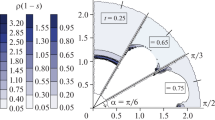Abstract
It is known that the nucleation of stars in the universe occurs, as a rule, in areas of the interstellar medium, where nebulae - gas and dust clouds consisting of molecular hydrogen, can collide with each other, changing their state during dynamic interaction with gravitational and magnetic fields. The gravitational-turbulent description of these processes is quite common in explaining the reasons for the creation of pre-stellar regions as a consequence of the collision of molecular clouds. We adhere to this approach with some simplification, assuming that the main factor in the dynamic transformations of gas formations is the influence on the collision process of mainly the kinetic energy of the clouds, separating these effects from the effects of gravitational collapse and from the influence of magnetic fields. To simulate gas-dynamic processes of different scales, a parallel numerical code was developed using grids with improved resolution, which was used in a numerical experiment on high-performance computers. The simulation showed that sharp changes in the distribution of matter in the shock core of new formations can be triggered by the Kelvin-Helmholtz instability and nonlinear thin-shell instability, which lead to sharp perturbations of the gas density in the resulting clumps, outer shells and gas filaments, with density fluctuations in the external interstellar medium. A predictive analysis of the appearance of possible pre-stellar zones during the evolution of new cloud formations is given.
Access this chapter
Tax calculation will be finalised at checkout
Purchases are for personal use only
Similar content being viewed by others
References
Dobbs C.L., et al.: Formation of molecular clouds and global conditions for star formation. In: Beuther, H., Klessen, R., Dullemont, C., Henning, Th. (eds.) Protostars & Planets VI, pp. 3–26. Univ. of Arizona Press (2014)
Special Issue: Star formation triggering by cloud-cloud collision. Publ. Astron. Soc. Jpn – PASJ 70(SP2) (2018)
Fukui, Y., Ohama, A., Hanaoka, N., et al.: Molecular clouds toward the super star cluster NGC 3603. Possible evidence for a cloud-cloud collision in triggering the cluster formation. Astrophys. J. 780(36), 13 (2014)
Ohama, A., Dawson, J.R., Furukawa, N., et al.: Temperature and density distribution in the molecular gas toward Westurlund 2: further evidence for physical associations. Astrophys. J. 709, 975–982 (2010)
Habe, A., Ohta, K.: Gravitational instability induced by a cloud-cloud collision: the case of head-on collision between clouds with different sizes and densities. Publ. Astron. Soc. Jpn. 44, 203–226 (1992)
Anathpindika, S.V.: Collision between dissimilar clouds: stability of the bow-shock and the formation of pre-stellar cores. Mon. Not. R. Astron. Soc. 405, 1431–1443 (2010)
Takahira, K., Shima, K., Tasker, E.J., Habe, A.: Formation of massive, dense cores by cloud-cloud collisions. PASJ 70(SP2), 1–24 (2018)
Haworth, T.J., et al.: Isolating signatures of major cloud–cloud collisions – II. The lifetimes of broad bridge features. MNRAS 454, 1634–1643 (2015)
Torii, K., et al.: Triggered O star formation in M20 via cloud-cloud collision: comparisons between high-resolution CO observations and simulations. Astrophys. J. 835(142), 1–12 (2017)
Wu, B., Tan, J.C., Nakamura, F., Van Loo, S, Christie, D., Collins, D.: GMC collisions as triggers of star formation. II. 3D turbulent, magnetized simulations. Astrophys. J. 835(137), 1–23 (2017)
Shima, K., Tasker, E.J., Federrath, C., Habe, A.: Does feedback help or hinder star formation? The effect of photoionization on star formation in giant molecular clouds. PASJ 70(SP2), 1–19 (2018)
Folini, D., Walder, R.: Supersonic turbulence in shock-bound interaction zones I. Symmetric settings. Astron. Astrophys. 459, 1–19 (2006)
Klein, R.I., Woods, D.T.: Bending mode instabilities and fragmentation in interstellar cloud collisions: a mechanism for complex structure. Astrophys. J. 497, 777–799 (1998)
Vishniac, E.T.: Nonlinear instabilities in shock-bounded slabs. Astrophys. J. 428, 186–208 (1994)
McLeod, A.D., Whitworth, A.P.: Simulations of the non-linear thin shell instability. MNRAS 431, 710–721 (2013)
Rybakin, B.P., Shider, N.I.: Development of parallel algorithms for solving the problems of gravitational gas dynamics. J. Vychisl. Metody Programm. 11(4), 388–394 (2010)
Rybakin, B., Goryachev, V.: Modeling of density stratification and filamentous structure formation in molecular clouds after shock wave collision. Comput. Fluids 173, 189–194 (2018)
Nakamura, F., McKee, Ch.F., Klein, R.I., Fisher, R.T.: On the hydrodynamic interaction of shock waves with interstellar clouds. II. The effect of smooth cloud boundaries on cloud destruction and cloud turbulence. Astrophys. J. 164, 477–505 (2006)
Pittard, J.M., Falle, S.A.E.G., Hartquist, T.W., Dyson, J.E.: The turbulent destruction of clouds. MNRAS 394, 1351–1378 (2009)
Melioli, C., De Gouveia, D.P.E., Raga, A.: Multidimensional hydro dynamical simulations of radiative cooling SNRs-clouds interactions: an application to starburst environments. Astron. Astrophys. 443, 495–508 (2005)
Kainulainen, J., Federrath, C., Henning, T.: Unfolding the laws of star formation: the density distribution of molecular clouds. Science 344(6180), 183–185 (2014)
Lada, C.J., Lombardi, M., Alves, J.F.: On the Star formation rates in molecular clouds. Astrophys. J. 724, 687–693 (2010)
Federrath, C., Banerjee, R., Clark, P.C., Klessen, R.S.: Modeling collapse and accretion in turbulent gas clouds: implementation and comparison of sink particles in AMR and SPH. APJ 713, 269–290 (2010)
Acknowledgements
This work has been supported by RFBR Grant 19-29-09070.
Author information
Authors and Affiliations
Corresponding author
Editor information
Editors and Affiliations
Rights and permissions
Copyright information
© 2020 Springer Nature Switzerland AG
About this paper
Cite this paper
Rybakin, B., Goryachev, V. (2020). Nonlinear Bending Instabilities Accompanying Clump and Filament Formation in Collisions of Nebulae. In: Voevodin, V., Sobolev, S. (eds) Supercomputing. RuSCDays 2020. Communications in Computer and Information Science, vol 1331. Springer, Cham. https://doi.org/10.1007/978-3-030-64616-5_23
Download citation
DOI: https://doi.org/10.1007/978-3-030-64616-5_23
Published:
Publisher Name: Springer, Cham
Print ISBN: 978-3-030-64615-8
Online ISBN: 978-3-030-64616-5
eBook Packages: Computer ScienceComputer Science (R0)




